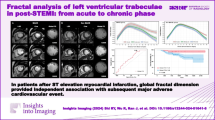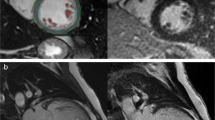Abstract
Objectives
The present study aimed to investigate the incremental prognostic value of the right ventricular fractal dimension (FD), a novel marker of myocardial trabecular complexity by cardiac magnetic resonance (CMR) in patients with arrhythmogenic cardiomyopathy (ACM).
Methods
Consecutive patients with ACM undergoing CMR were followed up for major cardiac events, including sudden cardiac death, aborted cardiac arrest, and appropriate implantable cardioverter defibrillator intervention. Prognosis prediction was compared by Cox regression analysis. We established a multivariable model supplemented with RV FD and evaluated its discrimination by Harrell’s C-statistic. We compared the category-free, continuous net reclassification improvement (cNRI) and integrated discrimination index (IDI) before and after the addition of FD.
Results
A total of 105 patients were prospectively included from three centers and followed up for a median of 60 (48, 66) months; experienced 36 major cardiac events were recorded. Trabecular FD displayed a strong unadjusted association with major cardiac events (p < 0.05). In the multivariable Cox regression analysis, RV maximal apical FD maintained an independent association with major cardiac events (hazard ratio, 1.31 (1.11–1.55), p < 0.002). The Hosmer–Lemeshow goodness of fit test displayed good fit (X2 = 0.68, p = 0.99). Diagnostic performance was significantly improved after the addition of RV maximal apical FD to the multivariable baseline model, and the continuous net reclassification improvement increased 21% (p = 0.001), and the integrated discrimination index improved 16% (p = 0.045).
Conclusions
In patients with ACM, CMR-assessed myocardial trabecular complexity was independently correlated with adverse cardiovascular events and provided incremental prognostic value.
Clinical relevance statement
The application of FD values for assessing RV myocardial trabeculae may become an accessible and promising parameter in monitoring and early diagnosis of risk factors for adverse cardiovascular events in patients with ACM.
Key Points
• Ventricular trabecular morphology, a novel quantitative marker by CMR, has been explored for the first time to determine the severity of ACM.
• Patients with higher maximal apical fractal dimension of RV displayed significantly higher cumulative incidence of major cardiac events.
• RV maximal apical FD was independently associated with major cardiac events and provided incremental prognostic value in patients with ACM.






Similar content being viewed by others
Abbreviations
- ACM:
-
Arrhythmogenic cardiomyopathy
- ALVC:
-
Arrhythmogenic left ventricular cardiomyopathy
- ARVC:
-
Arrhythmogenic right ventricular cardiomyopathy
- ARVD:
-
Arrhythmogenic right ventricular dysplasia
- DSG2:
-
Desmoglein-2
- DSP:
-
Desmoplakin
- FD:
-
Fractal dimension
- NSVT:
-
Non-sustained ventricular tachycardia
- PKP2:
-
Plakophilin-2 gene
- PVC:
-
Premature ventricular complex
- TFC:
-
Task Force Criteria
- TWI:
-
Inverted T-wave
References
Towbin JA, McKenna WJ, Abrams DJ et al (2019) 2019 HRS expert consensus statement on evaluation, risk stratification, and management of arrhythmogenic cardiomyopathy. Heart Rhythm 16:e301–e372
Corrado D, Zorzi A, Cipriani A et al (2021) Evolving diagnostic criteria for arrhythmogenic cardiomyopathy. J Am Heart Assoc 10:e021987
Aquaro GD, De Luca A, Cappelletto C et al (2020) Prognostic value of magnetic resonance phenotype in patients with arrhythmogenic right ventricular cardiomyopathy. J Am Coll Cardiol 75:2753–2765
Tandri H, Calkins H, Nasir K et al (2003) Magnetic resonance imaging findings in patients meeting Task Force Criteria for arrhythmogenic right ventricular dysplasia. J Cardiovasc Electrophysiol 14:476–482
Molinari G, Sardanelli F, Gaita F et al (1995) Right ventricular dysplasia as a generalized cardiomyopathy? Findings on magnetic resonance imaging. Eur Heart J 16:1619–1624
Petersen SE, Jensen B, Aung N et al (2023) Excessive trabeculation of the left ventricle: JACC: Cardiovascular Imaging Expert Panel Paper. JACC Cardiovasc Imaging 16:408–425
Malik N, Mukherjee M, Wu KC et al (2022) Multimodality imaging in arrhythmogenic right ventricular cardiomyopathy. Circ Cardiovasc Imaging 15:e013725
Cipriani A, Mattesi G, Bariani R et al (2023) Cardiac magnetic resonance imaging of arrhythmogenic cardiomyopathy: evolving diagnostic perspectives. Eur Radiol 33:270–282
Corrado D, PerazzoloMarra M, Zorzi A et al (2020) Diagnosis of arrhythmogenic cardiomyopathy: the Padua criteria. Int J Cardiol 319:106–114
Dawes TJW, Cai J, Quinlan M et al (2018) Fractal analysis of right ventricular trabeculae in pulmonary hypertension. Radiology 288:386–395
Meyer HV, Dawes TJW, Serrani M et al (2020) Genetic and functional insights into the fractal structure of the heart. Nature 584:589–594
Yu S, Chen X, Yang K et al (2022) Correlation between left ventricular fractal dimension and impaired strain assessed by cardiac MRI feature tracking in patients with left ventricular noncompaction and normal left ventricular ejection fraction. Eur Radiol 32:2594–2603
Captur G, Zemrak F, Muthurangu V et al (2015) Fractal analysis of myocardial trabeculations in 2547 study participants: multi-ethnic study of atherosclerosis. Radiology 277:707–715
Captur G, Muthurangu V, Cook C et al (2013) Quantification of left ventricular trabeculae using fractal analysis. J Cardiovasc Magn Reson 15:36
Wang J, Li Y, Yang F et al (2021) Fractal analysis: prognostic value of left ventricular trabecular complexity cardiovascular MRI in participants with hypertrophic cardiomyopathy. Radiology 298:71–79
Captur G, Lopes LR, Patel V et al (2014) Abnormal cardiac formation in hypertrophic cardiomyopathy: fractal analysis of trabeculae and preclinical gene expression. Circ Cardiovasc Genet 7:241–248
Captur G, Lopes LR, Mohun TJ et al (2014) Prediction of sarcomere mutations in subclinical hypertrophic cardiomyopathy. Circ Cardiovasc Imaging 7:863–871
Kramer CM, Barkhausen J, Bucciarelli-Ducci C, Flamm SD, Kim RJ, Nagel E (2020) Standardized cardiovascular magnetic resonance imaging (CMR) protocols: 2020 update. J Cardiovasc Magn Reson 22:17
Zghaib T, Te Riele A, James CA et al (2021) Left ventricular fibro-fatty replacement in arrhythmogenic right ventricular dysplasia/cardiomyopathy: prevalence, patterns, and association with arrhythmias. J Cardiovasc Magn Reson 23:58
Camporeale A, Moroni F, Lazzeroni D et al (2022) Trabecular complexity as an early marker of cardiac involvement in Fabry disease. Eur Heart J Cardiovasc Imaging 23:200–208
Li C, Huang R, Ding Z, Gatenby JC, Metaxas DN, Gore JC (2011) A level set method for image segmentation in the presence of intensity inhomogeneities with application to MRI. IEEE Trans Image Process 20:2007–2016
Captur G, Radenkovic D, Li C et al (2017) Community delivery of semiautomated fractal analysis tool in cardiac MR for trabecular phenotyping. J Magn Reson Imaging 46:1082–1088
Gasperetti A, Carrick RT, Costa S et al (2022) Programmed ventricular stimulation as an additional primary prevention risk stratification tool in arrhythmogenic right ventricular cardiomyopathy: a multinational study. Circulation. https://doi.org/10.1161/CIRCULATIONAHA.122.060866
Cadrin-Tourigny J, Bosman LP, Nozza A et al (2019) A new prediction model for ventricular arrhythmias in arrhythmogenic right ventricular cardiomyopathy. Eur Heart J 40:1850–1858
McCullough J, Perera RG (2022) Arrhythmogenic right ventricular cardiomyopathy. N Engl J Med 387:e20
Vogel-Claussen J, Shehata ML, Lossnitzer D et al (2011) Increased right ventricular septomarginal trabeculation mass is a novel marker for pulmonary hypertension: comparison with ventricular mass index and right ventricular mass. Invest Radiol 46:567–575
van de Veerdonk MC, Dusoswa SA, Marcus JT et al (2014) The importance of trabecular hypertrophy in right ventricular adaptation to chronic pressure overload. Int J Cardiovasc Imaging 30:357–365
Te Riele AS, James CA, Philips B et al (2013) Mutation-positive arrhythmogenic right ventricular dysplasia/cardiomyopathy: the triangle of dysplasia displaced. J Cardiovasc Electrophysiol 24:1311–1320
Chun KH, Oh J, Hong YJ et al (2022) Prognostic cardiac magnetic resonance markers of left ventricular involvement in arrhythmogenic cardiomyopathy for predicting heart failure outcomes. J Am Heart Assoc 11:e023167
Dowd R, Dhanjal T, Schmucki M, Kanagala P, Khan JN (2021) Unique role of cardiovascular magnetic resonance imaging parametric mapping in the diagnosis of arrhythmogenic left ventricular cardiomyopathy. Eur Heart J Cardiovasc Imaging 22:e96
PerazzoloMarra M, Cipriani A, Rizzo S et al (2021) Myocardial tissue characterization in arrhythmogenic cardiomyopathy: comparison between endomyocardial biopsy and cardiac magnetic resonance. JACC Cardiovasc Imaging 14:1675–1678
Funding
Supported by the National Natural Science Foundation of China (No. 82171884); and Shanghai Jiao Tong University Medical Engineering Cross Project (No. YG2022QN016).
Author information
Authors and Affiliations
Corresponding authors
Ethics declarations
Guarantor
The scientific guarantor of this publication is Lian-Ming Wu.
Conflict of interest
The authors state that there neither exists a conflict of interest nor that there is financial information to disclose.
Statistics and biometry
Lian-Ming Wu kindly provided statistical advice for this manuscript.
Informed consent
Written informed consent was obtained from all participants in this study.
Ethical approval
Institutional Review Board approval was obtained. The CMR study protocol was approved by each of the institutional ethics committees (Shanghai Renji Hospital, Beijing Anzhen Hospital, and Fujian Longyan First Hospital) and was conducted according to the Declaration of Helsinki.
Study subjects or cohorts overlap
Study subjects or cohorts have not been previously reported.
Methodology
• prospective
• observational
• multicenter study
Additional information
Publisher's Note
Springer Nature remains neutral with regard to jurisdictional claims in published maps and institutional affiliations.
Supplementary Information
Below is the link to the electronic supplementary material.
Rights and permissions
Springer Nature or its licensor (e.g. a society or other partner) holds exclusive rights to this article under a publishing agreement with the author(s) or other rightsholder(s); author self-archiving of the accepted manuscript version of this article is solely governed by the terms of such publishing agreement and applicable law.
About this article
Cite this article
Chen, BH., Jiang, WY., Zheng, JY. et al. Prognostic value of right ventricular trabecular complexity in patients with arrhythmogenic cardiomyopathy. Eur Radiol (2024). https://doi.org/10.1007/s00330-023-10561-y
Received:
Revised:
Accepted:
Published:
DOI: https://doi.org/10.1007/s00330-023-10561-y




